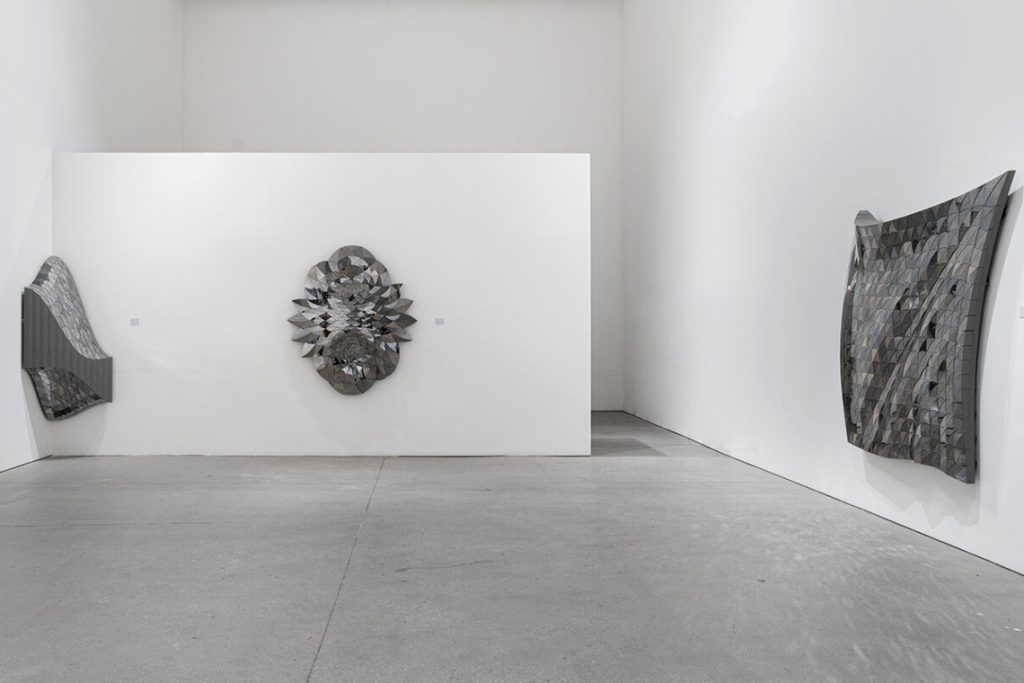In his current show, Immortal Mirror, at Leila Heller Dubai, Aref Montazeri invites his audience to look inwards on a journey to unseen and unknown realities.
“I practised elegance with Monir and technical possibilities with Parviz,” suggests Aref Montazeri, an Iranian mirror artist whose artistic career commenced through collaboration with Monir Shahroudy Farmanfarmaian on a collection of sculptural works, coupled with the opportunity to apprentice under Parviz Tanavoli. Later, he established his own visual language, transitioning from ornamentalism to grounding mirrorwork in human experiences –an approach he terms “mirror follows narrative”.
Montazeri’s labour-intensive compositions, taking years to produce, often embody intimate narratives and delve into the psychological effects of the mirror. His last solo show expressed reflections on his mother’s departure, as she left his father and their family home. Wearing her abandoned clothes, he contemplated his reflection in the mirror, connecting to her presence and distilling this memory into his art. It’s work that embraces the mirror’s ability to reflect realities beyond oneself and marked Montazeri’s first attempt to engage the audience in the mirror’s physicality.

Negotiating the dynamic between the individual, their reflection and the passage of time, in his most recent body of work, presented in Immortal Mirror at Leila Heller, Montazeri leant into the realm of psychoanalysis, particularly Jacques Lacan’s conceptualisation of the ‘mirror stage’ in the early formation of the ego. According to Lacan, the image reflected back symbolises the “Ideal I” – a stable and autonomous version that a child yearns to embody but can never directly experience. This pursuit of the ideal self, Lacan argues, remains unfulfilled and might lead to feelings of anxiety, neurosis and psychosis. In Montazeri’s mirrorwork, curved edges and contemporary geometries come together to cast disorienting visions.
As the spectator moves through Immortal Mirror, the artist rendered them self-conscious; the distorted self appears through several large-scale compositions. Through manipulation of scale, Montazeri achieved tension. The magnitude of the works, mounted upon the wall –weighing up to 200 kg and two metres in diameter – impose a sense of gravity on the room, yet each precisely cut mirror remained light in its own right.

Montazeri’s works unfolds in three temporal dimensions: aged layers evoking the past, present forms scrutinised by the audience, and the envisioning of an immortalised future through oxidised layers of mirrorwork. How, then, to capture the fleeting notion of time upon a surface that is ever-shifting? Utilising chemical oxidation, Montazeri translates the abstract concept of time into tangible traces on his mirrors, transforming the reflective surface into a complex plane that beckons contemplation.
A sense of order and structure evolves in the works, rooted in the artist’s interest in architecture and indicative of the influence of Tanavoli, particularly apparent in Immortal Mirror 7. Here, a wave of muted aluminium disrupts the curvature of the mirrorwork. The opposing relationship between these materials and their surroundings imparted a sense of reality back into the composition. Through a contemporary approach to geometry, Montazeri liberates his compositions from conventional flatness, presenting fluid 3D shapes – curved and organic forms that pull the viewer in. Immortal Mirror 1 stands apart from the other works in this series; the mirror’s concave form was echoed in the carpet that lay before it on the floor. Through the juxtaposition of materials, the artist dances between tangible and imagined realities, the muted and fixed character of the pewter rug, and the animated surface of the mirror.

While Montazeri’s mirrors remained fixed, the spectator was always on the move; as such, the surface was ever-shifting and in continuous dialogue with its surroundings. The artist, like Jeff Koons and Yayoi Kusama, seeks to intertwine society in his creations. By momentarily halting time and through subtle confrontation, in Immortal Mirror he invites the audience to explore their past, present and future as well as their own fragmented image. The polished surfaces of the mirrors retain their original function – reflecting back the essence of the viewer, albeit in a warped manner. Through his manipulation of identity, space and time, Montazeri prompted observers to contemplate: are these images truly warped, or have we been witness to a hidden or deeper reality?



